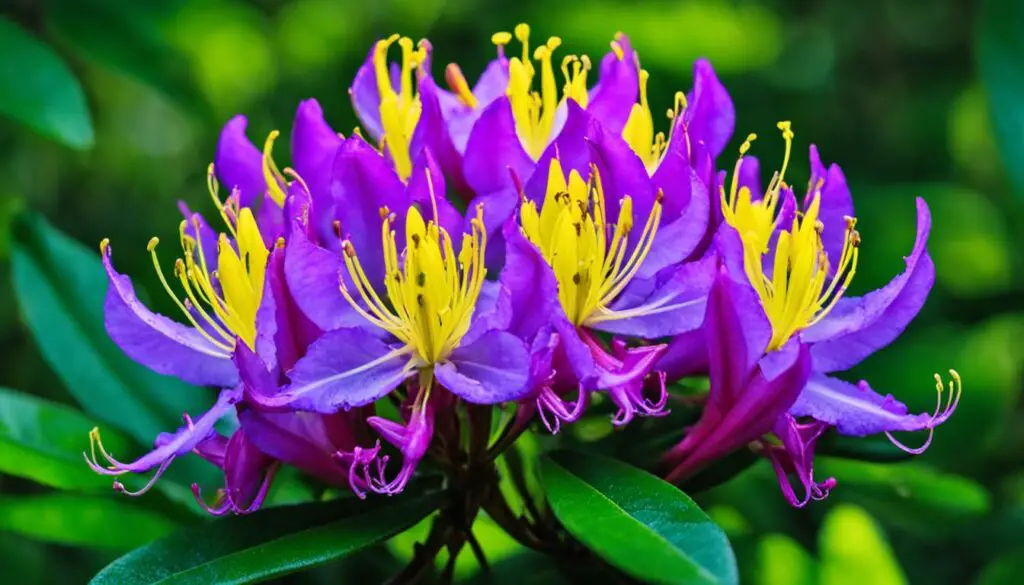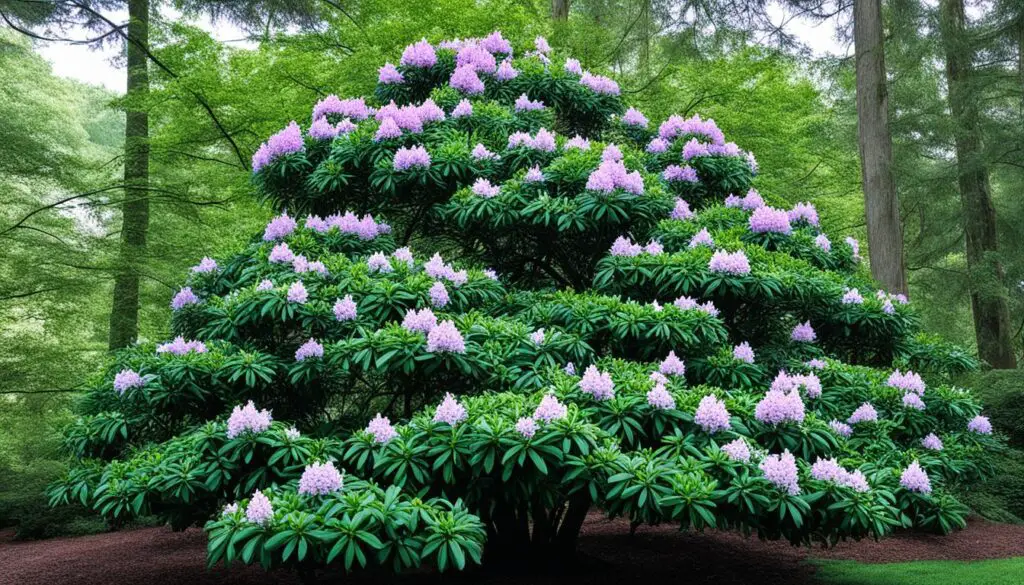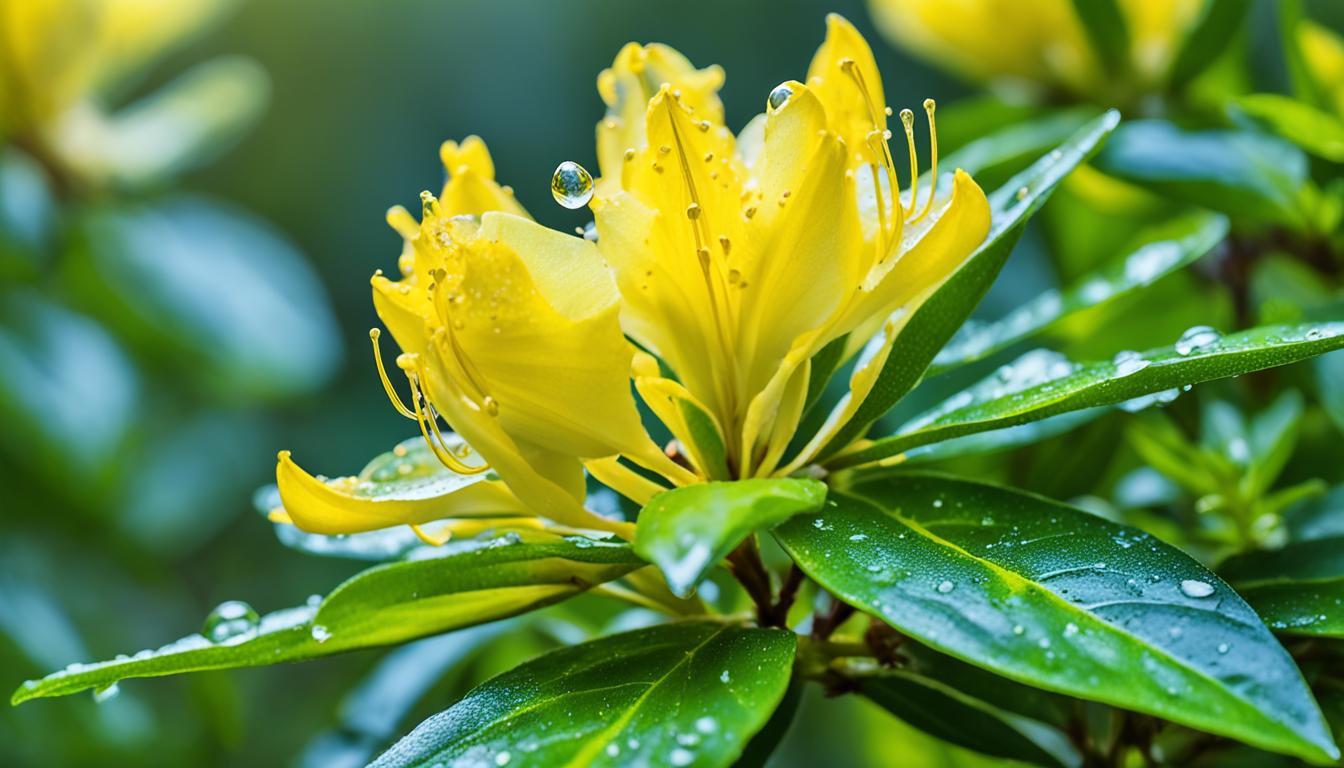Welcome to our comprehensive guide on caring for Rhododendron austrinum plants. Whether you’re a seasoned gardener or a beginner, this article will provide you with all the information you need to ensure your Rhododendron austrinum plants thrive and bloom beautifully. From optimal growing conditions to seasonal care practices, we have you covered. Let’s dive in!
Key Takeaways:
- Provide well-drained, sandy soil and maintain the ideal pH level for Rhododendron austrinum.
- Ensure the plant receives proper light, with a preference for partial shade.
- Water the plant adequately, avoiding waterlogging but keeping the soil moist.
- Follow the right planting and propagation techniques for successful growth.
- Implement seasonal care practices such as fertilization, pruning, and deadheading.
Introduction to Rhododendron Austrinum

Allow us to introduce you to the beauty of Rhododendron austrinum, commonly known as the Florida azalea or yellow azalea. This striking flowering plant is sure to capture the attention of any garden enthusiast. With its vibrant yellow blooms, Rhododendron austrinum adds a cheerful touch to any landscape.
Rhododendron austrinum is characterized by its medium-sized shrub-like habit, reaching approximately 6 to 10 feet in height. Its deciduous foliage adds interest throughout the year, with the leaves turning a beautiful red or purple color in the fall. The bright yellow flowers, which typically appear in early spring, create a stunning contrast against the backdrop of green foliage.
This species of Rhododendron is native to the southeastern United States, especially in Florida and Georgia. It thrives in warm climates and is well adapted to the sandy soils commonly found in its native habitat. Rhododendron austrinum is often found growing in swampy areas, pinelands, and along the banks of streams.
Optimal Growing Conditions for Rhododendron Austrinum

Creating the perfect growing conditions is crucial for the successful cultivation of Rhododendron austrinum. This section will outline the essential requirements for soil composition, pH levels, light exposure, and watering techniques that will ensure the healthy growth and vibrant blooms of this stunning plant.
Preferred Soil Composition and pH
In order to thrive, Rhododendron austrinum requires well-drained, sandy soil that allows for proper root development and prevents waterlogging. The ideal pH range for this plant is between 4.5 and 6.0, which signifies an acidic soil environment. It is recommended to use a mixture of peat moss, pine bark, and perlite to achieve the desired soil composition.
Light Requirements: Understanding Shading Needs
Rhododendron austrinum prefers partial shade and should be protected from direct afternoon sun. Ideally, it should be placed in locations that receive morning sun or all-day heavily filtered sun. Alternatively, growing the plant in all-day dappled shade is also suitable, as it mimics the natural conditions in which Rhododendron austrinum thrives.
Watering Techniques for Adequate Moisture
Proper watering is essential for the health of Rhododendron austrinum. It is important to maintain adequate moisture levels in the soil, while avoiding excessive wetness that can lead to root rot. Regularly check the soil moisture using your finger, and water the plant when the top inch of soil feels dry. Remember to water deeply, ensuring the water reaches the entire root system, but be cautious not to overwater.
Planting and Propagation Tips
Proper planting and propagation techniques are essential for the successful growth and propagation of Rhododendron austrinum. Follow these tips to ensure optimal results.
Steps for Successful Seed Germination
Seed germination is a popular method for propagating Rhododendron austrinum. Follow these steps to increase the chances of successful germination:
- Start by collecting ripe seeds from healthy parent plants. Look for mature seed capsules that have naturally split open.
- Clean the seeds by removing any debris or chaff.
- Create a germination medium by combining equal parts of peat moss, perlite, and vermiculite.
- Moisten the germination medium to make it damp but not soggy.
- Sow the seeds lightly on the surface of the germination medium.
- Cover the seeds with a thin layer of fine sand or vermiculite.
- Place the container in a plastic bag or cover it with a plastic dome to maintain humidity.
- Keep the container in a warm location with indirect light.
- Maintain consistent moisture levels by misting the seeds regularly.
- Germination typically takes 4 to 8 weeks. Once the seedlings have developed their first true leaves, they can be transplanted into individual pots or into the garden.
By following these steps, you can increase the chances of successful seed germination and establish a healthy population of Rhododendron austrinum plants.
Seasonal Care for Sustained Blooms
Proper seasonal care is essential for ensuring vibrant blooms and healthy growth in Rhododendron austrinum plants. This section will provide valuable insights into two important aspects of maintaining these beautiful flowers: fertilization and pruning.
Fertilization Schedule for Vibrant Flowers
A well-planned fertilization schedule is crucial for maximizing the vibrancy and longevity of Rhododendron austrinum blooms. To promote healthy growth, it is recommended to fertilize these plants in early spring, just before the active growing season begins, and again in late spring or early summer.
When selecting fertilizers, opt for formulations specifically designed for acid-loving plants, as Rhododendron austrinum thrives in slightly acidic soil. Look for products with a balanced NPK (nitrogen, phosphorus, and potassium) ratio, ideal for promoting overall plant health and robust flower production.
Follow the manufacturer’s guidelines for application rates, as over-fertilization can lead to nutrient imbalances and potential damage to the plant. It is important to note that excessive nitrogen can result in lush foliage growth at the expense of flower production. Therefore, be mindful of the dosage and avoid using high-nitrogen fertilizers in excess.
Pruning and Deadheading Practices
Pruning is integral to maintaining the shape, size, and overall health of Rhododendron austrinum plants. This process involves removing dead, diseased, or damaged branches, encouraging new growth, and enhancing the plant’s aesthetic appeal.
Start pruning immediately after flowering, typically in late spring or early summer, taking care to avoid cutting off next season’s flower buds. Use clean, sharp pruning shears to make clean cuts just above a set of healthy leaves or an outward-facing bud.
Deadheading, the removal of spent flowers, is crucial for promoting continuous blooming in Rhododendron austrinum. Regular deadheading prevents the plant from directing its energy towards seed production, allowing it to redirect resources towards new flower development.
By incorporating regular pruning and deadheading into your maintenance routine, you can rejuvenate the plant, encourage healthy growth, and enjoy the vibrant blooms of Rhododendron austrinum throughout the growing season.
Protecting Rhododendron Austrinum from Pests and Diseases
Rhododendron austrinum plants are susceptible to various pests and diseases that can compromise their health and vitality. It is essential to take proactive measures to protect your plants from these potential threats and ensure their long-term well-being. By implementing effective pest control strategies and disease prevention techniques, you can safeguard your Rhododendron austrinum plants and promote their optimal growth and blooming.
Regular monitoring is crucial for identifying any pest infestations or signs of diseases early on. Inspect the leaves, stems, and flowers of your plants regularly, looking for any abnormalities, such as discoloration, spots, or wilting. Should you observe any issues, take immediate action to prevent further damage.
Proper sanitation practices play a vital role in preventing the spread of pests and diseases. Remove any fallen leaves, debris, or dead plant materials from around your Rhododendron austrinum plants. These can serve as breeding grounds for pests and harbor disease pathogens. Regularly clean your gardening tools and equipment to prevent cross-contamination.
When it comes to pest control, consider using organic methods whenever possible. Beneficial insects, such as ladybugs and lacewings, can help control common pests like aphids and caterpillars naturally. Additionally, neem oil or insecticidal soaps can be used to treat certain pest infestations safely.
In some cases, chemical controls may be necessary to combat stubborn pest infestations or diseases. Consult with a local gardening expert or extension service to identify the appropriate pesticides to use and follow the instructions carefully. Always remember to prioritize the safety of your plants and the environment when choosing and applying chemical controls.
Conclusion
In conclusion, caring for Rhododendron austrinum plants requires attention to detail and adherence to specific guidelines. By providing optimal growing conditions, such as well-drained soil with the appropriate pH level, and ensuring the right amount of shading and moisture, you can create an ideal environment for these beautiful azaleas to thrive.
Proper planting and propagation techniques play a crucial role in the successful growth of Rhododendron austrinum. Following the steps for successful seed germination and transplanting seedlings will give your plants a strong foundation for healthy development.
Seasonal care, including fertilization and pruning, is essential for sustained blooms. Implementing a fertilization schedule and practicing regular pruning and deadheading will encourage vibrant flowers and promote continuous blooming throughout the season.
Lastly, it is important to protect Rhododendron austrinum from common pests and diseases. Regular monitoring, proper sanitation, and the use of organic or chemical controls when necessary will help keep these threats at bay and ensure the overall health and well-being of your plants.
By following these guidelines and implementing proper care practices, you can enjoy the beauty of Rhododendron austrinum in your garden for years to come.
